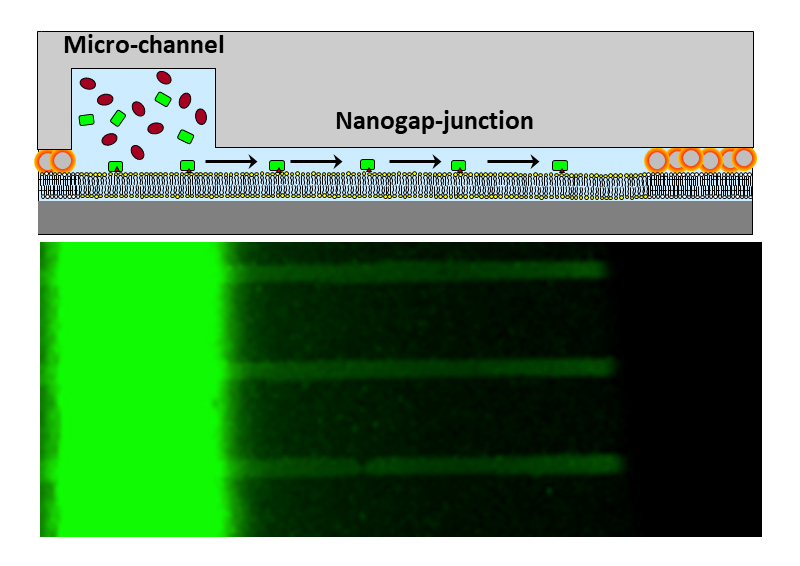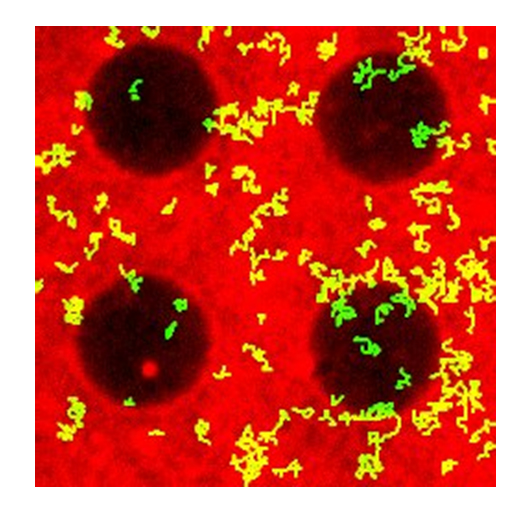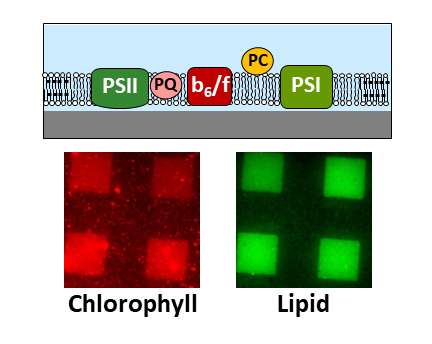Biological membranes represent a major frontier in the biological sciences, and they also offer opportunities in the biomedical technologies. Although they play essential roles in nearly all aspects of living organism, including signal transduction and energy conversion, their functions are not yet well understood owing to the complex and dynamic supramolecular nature of the membrane. We are developing a synthetic model system of the biological membranes on solid substrate to understand their functions and apply them to biomedical applications. We envisage that a robust, functional, and integrated model membrane would be applied in a wide range of biomedical applications.
(1) Patterned model membrane:
We have developed a patterned lipid membranes composed of polymerized and natural lipid bilayers. The polymeric bilayer acts as a framework that supports embedded lipid membranes with defined boundaries. The embedded natural lipid membranes, on the other hand, retain some essential physical/ chemical properties of the biological membrane such as fluidity and resistance towards non-specific adsorption. The two membranes can be integrated with a designed pattern. We are currently developing more complex and biologically relevant model systems based on this technique. We seek to construct a structurally controlled model system to mimic specific functions of the biological membrane.
(2) Membrane-nanofluidics
Selective and sensitive detection of specific molecules is a hallmark of the biological membrane, and is essential also in many biomedical applications, including diagnostics. We have developed a methodology to create a nanometric gap structure between the patterned membrane and a silicone elastomer (polydimethylsiloxane: PDMS) sheet by attaching them with an adhesion material (glue) having a finite thickness. We are developing a platform for single molecule analysis of membrane proteins and biomedical marker molecules using the membrane-nanofluidics.
(3) Signal transduction
Signal transduction is one of the most important functions of the biological membrane. Segregation and local enrichment of protein/ lipid components in rafts (micro-/ nano-domains), have been postulated to regulate the signal transduction. We develop a methodology to mimic raft with a patterned phase separation of lipids, and study the behaviors of reconstituted membrane proteins (receptors and transducers) to elucidate the influence of lateral heterogeneity on the signal transduction.
(4) Photosynthesis
Thylakoid membranes in the chloroplast of plants, algae, and cyanobacteria are the powerhouse of the photosynthesis capturing solar energy and converting it into chemical energy. Although photosynthetic reactions have been extensively studied, the intrinsically heterogeneous and dynamic nature of the membrane structures are still not fully understood. We are developing a methodology to reconstitute the whole thylakoid membrane into a patterned substrate-supported planar bilayer to study the membrane organization and machinery of photosynthesis.




